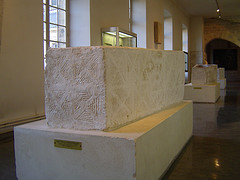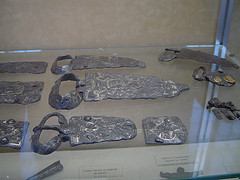

53 rue Simon
Tel. 03 26 85 23 36
Open: daily pm only
Closed:
Jan 1, May 1, Jul 14, Nov 1 & 11, Dec 25
The Saint-Remi museum in
Reims is a French museum located at no. 53 rue Simon in Reims (Marne,
Champagne-Ardenne, Grand-Est, France). This is the former Saint-Remi
abbey or former Hôtel-Dieu.
The idea of transforming the old abbey into a museum
dates back to the 1950s. Indeed, while the abbey was a hospital, the
local learned societies of the 19th century were already using part of
the cloister as a lapidary deposit. But it was not until August 1978
that the management of the Museums of France and the city of Reims
decided to officially create the museum, which received the status of
first-category controlled municipal museum. At the same time, from 1968,
the city of Reims and the historical monuments undertook a vast program
of restoration of the abbey which was slowly recovering from the
destruction of the First World War. The former royal Benedictine abbey
was classified as World Heritage by UNESCO in 1991. Being a heritage
element of the Reims hospital, it is the latter which signed a long
lease with the municipality.
The museum deals with the period
from Prehistory to the Renaissance (around 1530); in addition to the
regional archeology collections (prehistoric, Gallic, Gallo-Roman,
Merovingian and medieval periods), there are also those of classical
archeology (Greece, Etruria) and a magnificent series of ancient
weapons, equipment and uniforms, ranging from the sixteenth to the
nineteenth century. The distribution of the collections between the
rooms follows a thematic and chronological order.
The cloister
(dating from 1709), the old medieval parlor, the grand staircase of
honor (1778) and the chapter house from the Middle Ages evoke the
architectural splendor of what was the royal abbey of Saint-Remi,
guardian of the Holy Ampulla used for the coronations of the kings of
France. These rooms also house works of painting, in particular from the
Reims school.
The Gallo-Roman section is housed in the old
refectories and kitchens from the 17th century, on the ground floor.
Under the name of Durocortorum, Reims was the capital of the imperial
province of Belgium during the Roman period. Many testimonies of this
glorious past are visible in these rooms: mosaics, sculptures, funerary
stelae and pottery, models... We should also mention the tomb of Flavius
Jovin, general-in-chief of the Roman army in Gaul, originally from
Reims, who is the most beautiful ancient marble sarcophagus preserved in
France.
The tapestries room houses the sumptuous tapestry of the life
of Saint Remi which, in ten large tapestries, retraces the episodes of
the life and the miracles of the holy Apostle of Gaul. Made between 1523
and 1531, these tapestries were offered to the abbey by the Archbishop
of Reims, Robert de Lenoncourt.
Three small rooms illustrate the
history of the abbey and the basilica by means of a chronological
presentation of a majority of objects from the archaeological
excavations of the site (head of King Lothaire, foot of the candelabrum
of Saint Remi, Limousin enamels …).
The regional archeology section,
located on the first floor, includes seven large rooms allowing a
chronological circuit ranging from Prehistory to the end of the Middle
Ages; we will particularly notice the remains of the cenotaph of the
sons of Emperor Augustus (year IV after Jesus Christ). The Gothic room
honors the remains of buildings that have disappeared from Reims,
whether civil, religious, military or funerary. Of particular note are
the reconstruction of the first floor of the famous 13th century Maison
des Musiciens and the 17th century painting representing the ruined
Saint-Nicaise church.
The regional military history section recalls
that Reims has always been present at major military events in the
history of France, from the Gallic Wars to the German surrender on May
7, 1945. It is one of the most important collections of provincial
museums consisting of weapons, equipment, period uniforms on mannequins,
hairstyles, documents, scale models of ships and paintings including the
famous Charge of the Reichshoffen cuirassiers by Édouard Detaille.


The large staircase, raised at the same time as the façade and integrated into a large space of bay windows, is in the axis of the church's transept. It houses a portrait of the king, a copy of Hyacinthe Rigaud, in a frame of wrought iron railings by the Remois locksmith Revel. It was completed in 1778 by master mason Lecoq.
It is one of the best preserved remains of the 12th century state of the abbey. The room served as a link between the cloister, the rooms of the abbey and the entrance to the church. The floor having been rebuilt over time, the room has retained parts of the old paving, but also many carved capitals.
From October 6, 2017 to January 14, 2018: 1500. Treasures from the
late Middle Ages.
From March 22 to July 22, 2018: Virgin and Mother.
Virgins and Child from the Saint-Remi Museum.
From May 11 to
September 23, 2018: The Romans in Champagne. Rediscovery of the
collections of the Épernay museum.
From October 4, 2018 to January
13, 2019: The taste of Japan, travels and collections in the Meiji era,
around donations: Alfred Gérard and Pierre Detré.
From October 17,
2019 to January 19, 2020: The century of Colbert Reims in the 17th
century
Part of the 400th anniversary of the birth of Jean-Baptiste
Colbert, the exhibition traces the development of the city of Reims in
the 17th century. From the rise of the local bourgeoisie to the various
epidemics.
From May 29 to August 29, 2021: Reims-Afrique. Stories of
objects between two continents
From November 2022 to January 2023:
Sapiens exhibition.